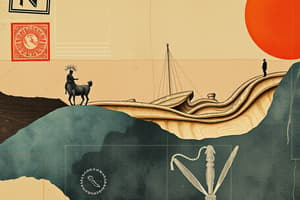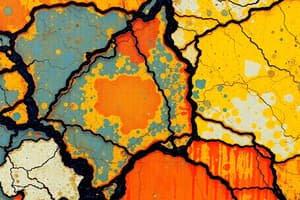Podcast
Questions and Answers
Steeper slopes experience slower erosion rates than gentler slopes.
Steeper slopes experience slower erosion rates than gentler slopes.
False (B)
Which of the following factors does NOT directly influence erosion rate?
Which of the following factors does NOT directly influence erosion rate?
- Type of rock
- Topography
- Population Density (correct)
- Climate
The transport of eroded material is referred to as the agent of erosion's ______.
The transport of eroded material is referred to as the agent of erosion's ______.
sediment load
What is the relationship between erosion and deposition?
What is the relationship between erosion and deposition?
Match the following factors with their influence on erosion rate:
Match the following factors with their influence on erosion rate:
Weathering is the process of moving weathered material from one place to another.
Weathering is the process of moving weathered material from one place to another.
Which of the following is NOT a type of mechanical weathering?
Which of the following is NOT a type of mechanical weathering?
The process of ______ involves the physical breakdown of rocks into smaller pieces without changing their chemical composition.
The process of ______ involves the physical breakdown of rocks into smaller pieces without changing their chemical composition.
What is the main difference between weathering and erosion?
What is the main difference between weathering and erosion?
Match the following types of weathering with their examples:
Match the following types of weathering with their examples:
Which of the following is NOT an agent of erosion?
Which of the following is NOT an agent of erosion?
Describe how a valley is formed by erosion.
Describe how a valley is formed by erosion.
Deposits of sediment at river mouths are called ______.
Deposits of sediment at river mouths are called ______.
Flashcards
Factors influencing erosion rate
Factors influencing erosion rate
Elements that affect how quickly erosion occurs, such as climate, topography, rock type, and vegetation.
Erosion and Deposition
Erosion and Deposition
Erosion is the process of moving material, while deposition is the placement of that material in a new location.
Sediment Load
Sediment Load
The amount and characteristics of soil and rock material transported by erosion agents.
Impact of Vegetation
Impact of Vegetation
Signup and view all the flashcards
Sedimentary Rocks Formation
Sedimentary Rocks Formation
Signup and view all the flashcards
Weathering
Weathering
Signup and view all the flashcards
Mechanical weathering
Mechanical weathering
Signup and view all the flashcards
Frost wedging
Frost wedging
Signup and view all the flashcards
Chemical weathering
Chemical weathering
Signup and view all the flashcards
Oxidation
Oxidation
Signup and view all the flashcards
Erosion
Erosion
Signup and view all the flashcards
Agents of erosion
Agents of erosion
Signup and view all the flashcards
Deltas
Deltas
Signup and view all the flashcards
Study Notes
Weathering
- Weathering is the process by which rocks break down into smaller pieces in place, without movement.
- Three main types of weathering:
- Mechanical weathering: Breaks down rocks physically without changing their chemistry. Examples:
- Frost wedging: Water expands in cracks when freezing, fracturing rock.
- Exfoliation: Rock layers peel off due to pressure release from uplift or erosion.
- Abrasion: Rocks rubbing against each other.
- Animal actions: Burrowing animals loosen and break up ground.
- Plant growth: Roots growing in cracks can wedge and break rocks.
- Chemical weathering: Changes the chemical makeup of rocks through reactions with water, air, or other substances. Examples:
- Oxidation: Reaction with oxygen, often leading to rust in iron-rich rocks.
- Hydrolysis: Reaction with water, breaking down minerals.
- Carbonation: Reaction with carbon dioxide, dissolving minerals like calcite.
- Acid rain: Rainwater containing dissolved acids.
- Biological weathering: Breakdown of rocks by living organisms, often involving chemical reactions. Examples:
- Plant roots: Roots exert pressure cracking rocks.
- Lichens: Lichens produce acids that chemically weather rocks.
- Burrowing animals: Animals loosen and break up rock and soil.
- Mechanical weathering: Breaks down rocks physically without changing their chemistry. Examples:
Erosion
- Erosion moves weathered rock and soil from one place to another due to wind, water, ice, or gravity.
- Agents of erosion:
- Water: Rivers, streams, rain, waves, ocean currents.
- Wind: Transports smaller particles like sand and dust.
- Glaciers: Move large amounts of rock and sediment.
- Gravity: Causes sediment movement downslope, alone or supporting other processes.
- Features of erosion:
- Valleys: Formed by rivers carving through rock.
- Canyons: Deep, V-shaped valleys carved by rivers in hard rock.
- Deltas: Triangular sediment deposits at river mouths.
- Alluvial fans: Cone-shaped deposits at mountain bases.
- Factors influencing erosion rate:
- Climate: Rainfall, temperature, and wind speed affect weathering and transport.
- Topography: Steeper slopes erode faster.
- Type of rock: Hard rocks erode slower; soft rocks faster.
- Vegetation: Plants anchor soil, reducing erosion.
- Erosion and Deposition: Erosion moves material; deposition drops it elsewhere. It's a cyclical process, interdependent.
- Sediment Load: Eroded material, characterized by size and composition, is transported.
- Sedimentary rocks: Compressed and cemented sediment forms sedimentary rocks.
Studying That Suits You
Use AI to generate personalized quizzes and flashcards to suit your learning preferences.




